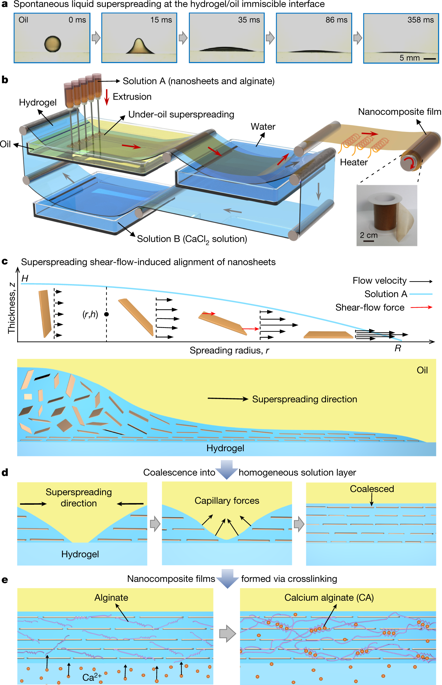Nature ( IF 50.5 ) Pub Date : 2020-04-08 , DOI: 10.1038/s41586-020-2161-8 Chuangqi Zhao 1 , Pengchao Zhang 2 , Jiajia Zhou 1, 3 , Shuanhu Qi 1, 3 , Yoshihiro Yamauchi 4 , Ruirui Shi 1 , Ruochen Fang 1 , Yasuhiro Ishida 4 , Shutao Wang 2 , Antoni P Tomsia 1, 5 , Mingjie Liu 1, 3, 5, 6 , Lei Jiang 1, 2, 5, 6

|
Biological materials, such as bones, teeth and mollusc shells, are well known for their excellent strength, modulus and toughness1,2,3. Such properties are attributed to the elaborate layered microstructure of inorganic reinforcing nanofillers, especially two-dimensional nanosheets or nanoplatelets, within a ductile organic matrix4,5,6. Inspired by these biological structures, several assembly strategies—including layer-by-layer4,7,8, casting9,10, vacuum filtration11,12,13 and use of magnetic fields14,15—have been used to develop layered nanocomposites. However, how to produce ultrastrong layered nanocomposites in a universal, viable and scalable manner remains an open issue. Here we present a strategy to produce nanocomposites with highly ordered layered structures using shear-flow-induced alignment of two-dimensional nanosheets at an immiscible hydrogel/oil interface. For example, nanocomposites based on nanosheets of graphene oxide and clay exhibit a tensile strength of up to 1,215 ± 80 megapascals and a Young’s modulus of 198.8 ± 6.5 gigapascals, which are 9.0 and 2.8 times higher, respectively, than those of natural nacre (mother of pearl). When nanosheets of clay are used, the toughness of the resulting nanocomposite can reach 36.7 ± 3.0 megajoules per cubic metre, which is 20.4 times higher than that of natural nacre; meanwhile, the tensile strength is 1,195 ± 60 megapascals. Quantitative analysis indicates that the well aligned nanosheets form a critical interphase, and this results in the observed mechanical properties. We consider that our strategy, which could be readily extended to align a variety of two-dimensional nanofillers, could be applied to a wide range of structural composites and lead to the development of high-performance composites.
中文翻译:

通过纳米片的剪切流诱导排列的层状纳米复合材料
生物材料,例如骨骼、牙齿和软体动物壳,以其出色的强度、模量和韧性1,2,3而闻名。这些特性归因于无机增强纳米填料的精细分层微结构,尤其是二维纳米片或纳米片,在韧性有机基质4,5,6内。受这些生物结构的启发,几种组装策略——包括逐层4,7,8,铸造9,10,真空过滤11,12,13和使用磁场14,15——已被用于开发层状纳米复合材料。然而,如何以通用、可行和可扩展的方式生产超强层状纳米复合材料仍然是一个悬而未决的问题。在这里,我们提出了一种在不混溶的水凝胶/油界面使用二维纳米片的剪切流诱导排列来生产具有高度有序层状结构的纳米复合材料的策略。例如,基于氧化石墨烯和粘土纳米片的纳米复合材料具有高达 1,215 ± 80 兆帕的拉伸强度和 198.8 ± 6.5 吉帕的杨氏模量,分别是天然珍珠层(母贝)的 9.0 倍和 2.8 倍。珍珠)。当使用粘土纳米片时,所得纳米复合材料的韧性可以达到每立方米36.7±3.0兆焦耳,是天然珍珠层的20.4倍;同时,抗拉强度为 1,195 ± 60 兆帕。定量分析表明,排列良好的纳米片形成了一个关键的界面,这导致了观察到的机械性能。我们认为我们的策略可以很容易地扩展到排列各种二维纳米填料,可以应用于广泛的结构复合材料,并导致高性能复合材料的发展。










































 京公网安备 11010802027423号
京公网安备 11010802027423号